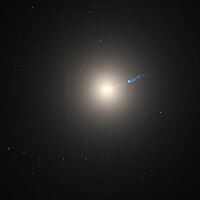Talk:Penrose process
| This article is rated Start-class on Wikipedia's content assessment scale. It is of interest to the following WikiProjects: | ||||||||||||||
‹See TfM›
| ||||||||||||||
Untitled
[edit]Would be nice to formalise the maths a bit more and use equation fonts. Or perhaps it is uncessary to bring algebra into what is only really a qualative description anyway? Nossac 20:55, 14 May 2006 (UTC)
It IS necessary (to bring... etc)! --85.141.88.191 (talk) 23:31, 26 February 2008 (UTC)
Dichotomy?
[edit]Is the use of this word in the context of the physical breaking up of an object once it enters the ergosphere really at all necessary here?
Shooting Star 14:38, 12 October 2007 (UTC)
References
[edit]I added a bunch of references for the efficiency claims. I also removed the statement "Demetrios Christodoulou calculated an upper bound for the amount of energy that can be extracted by the Penrose process." - not that I disbelieve it, but I can't find a clear reference to where he does it. Anders Sandberg (talk) 16:17, 6 September 2014 (UTC)
How can this be true?
[edit]
► the particle rotates with the black hole in a single direction only.
For a point on the surface of an object rotating around an x-axis, position (and momentum vectors) are continually traded between the y and z directions. That's two, not one. Verdana♥Bold 20:29, 21 June 2017 (UTC)
- PS: Why is my section heading larger than the previous two talk page sections? Verdana♥Bold 20:32, 21 June 2017 (UTC)
- You used single equal-signs instead of doubles. 97.80.84.84 (talk) 21:34, 14 October 2018 (UTC)
- I changed it to double signs so that it doesn't mess with the ToC structure. 97.80.84.84 (talk) 21:35, 14 October 2018 (UTC)
- See the image of the jet emanating from the ergosphere of M87* (at right). I can add more text in the caption if desired. If you are worried that we are seeing only one jet, Reva Williams has an explanation for that possibility from her calculations. --Ancheta Wis (talk | contribs) 11:06, 20 June 2021 (UTC)
Momentum to energy?
[edit]Momentum and energy do not have the same units. Momentum is conserved, not converted. It's the rotational kinetic energy that is converted to usable energy. 97.80.84.84 (talk) 21:34, 14 October 2018 (UTC)
Diving into the Ergosphere
[edit]"Penrose mechanism exploits that by diving into the ergosphere ..." While entering the ergosphere is necessary to get a net positive gain in energy, I believe one can increase spinward orbital velocity over an above the Oberth maneuver without having to enter the ergosphere. Someone should mention this. Cloudswrest (talk) 18:38, 10 April 2023 (UTC)
Penrose Process and the Photon Sphere
[edit]Absent some non-dissipating mechanical extraction system from the ergosphere, such as a "Ringworld" monorail rollercoaster, or a relativistic skyhook tether, it would seem to me to be impossible to extract energy via the Penrose Process. The problem is the ergosphere is below the photon sphere, and to increase altitude from below the photon sphere requires radial thrust due to centrifugal force reversal[1], which wastes energy.
Here's the scenario.
Probe enters the ergosphere. Probe impulsively shoots it wad anti-spinward. This increases probe's kinetic energy. *Translating* this new energy to infinite radius shows a net energy gain. "Translating this energy to infinite radius" is the problem, and it's not just technical, but fundamental. Here's the issue. Below the photon sphere one cannot escape by increasing tangential speed or thrusting tangentially, so shooting your wad anti-spinward will in no way help you escape the ergosphere. In fact it makes in worse. Increasing tangential speed below the photon sphere increases the radial pull on the probe! Assuming the probe is entirely self contained and independent of assistance from the outside, it must thrust radially to escape from the ergosphere and/or black hole, and this radial thrusting is going to consume any energy the probe gained from the Penrose process. Cloudswrest (talk) 03:24, 14 October 2023 (UTC)
- For rotating black holes the ergosphere can be well above the photon circular orbits (those with the same direction as the black hole rotation). You can see it on the illustration in the article that the probe leaves the ergosphere on its own, ballistically, and flies off to infinity. So, as long as the spin parameter is large enough (more than about .7 if I'm not mistaken) the probe can split above the innermost light orbit but inside the ergosphere and there's no problem. L3erdnik (talk) 17:49, 15 October 2023 (UTC)
References
- ^ Abramowicz, Marek (1990). "Centrifugal-force reversal near a Schwarzschild black hole". Monthly Notices of the Royal Astronomical Society. 245: 720. Bibcode:1990MNRAS.245..720A.

